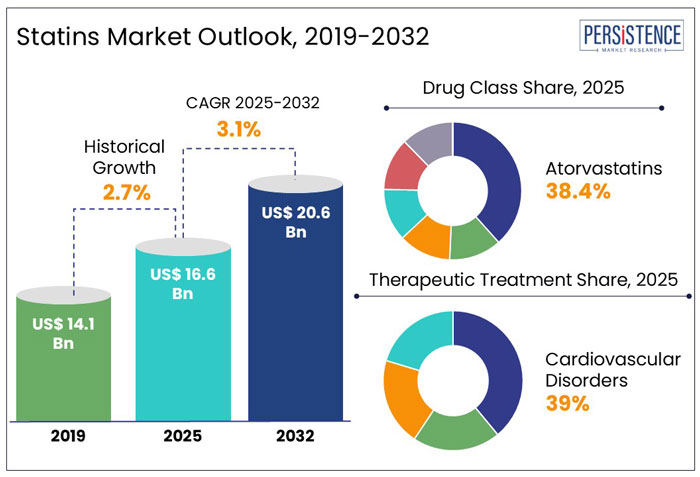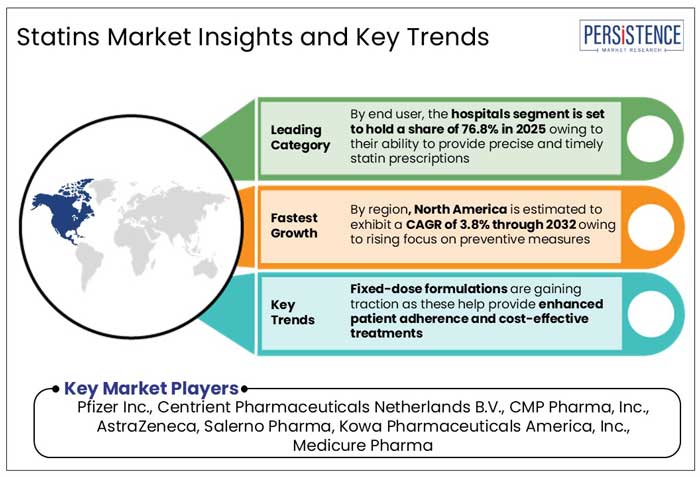Statins Market Segmented By Astrovastatins, Fluvastatins, Lovastatins, Pravastatins, Simvastatins Drug Class for Cardiovascular Disorders, Obesity, Inflammatory Disorders Treatment
Industry: Healthcare
Published Date: February-2025
Format: PPT*, PDF, EXCEL
Delivery Timelines: Contact Sales
Number of Pages: 189
Report ID: PMRREP3038
The global statins market is predicted to reach a size of US$ 16.6 Bn by 2025. It is anticipated to showcase a CAGR of 3.1% during the forecast period to attain a value of US$ 20.6 Bn by 2032.
As per Persistence Market Research (PMR), rising incidence of cardiovascular diseases like atherosclerosis, coronary artery disease, and stroke are prominent growth drivers. Aging population, especially in developed countries like the U.S., Europe, and Japan, is leading to an increasing number of patients requiring cholesterol-lowering medications like statins.
Statins are considered one of the most effective treatments to reduce cholesterol and prevent such diseases. Global prevalence of hyperlipidemia (high cholesterol) in adults is estimated to be 40% to 50%, further contributing to a high demand for statin drugs.

Key Highlights of the Industry
|
Global Market Attributes |
Key Insights |
|
Statins Market Size (2025E) |
US$ 16.6 Bn |
|
Market Value Forecast (2032F) |
US$ 20.6 Bn |
|
Projected Growth (CAGR 2025 to 2032) |
3.1% |
|
Historical Market Growth Rate (CAGR 2019 to 2024) |
2.7% |
Clinical Guidelines Reinforced Statins as First-line Treatment of Dyslipidemia from 2019 to 2024
The statins market growth was average at a CAGR of 2.7% during the historical period from 2019 to 2024. Nearly 18 million deaths annually are attributed to heart-related conditions, driving demand for lipid-lowering drugs like statins. Introduction of generic statins contributed to cost reduction and widespread adoption. For example,
Clinical guidelines from the American Heart Association (AHA) and the European Society of Cardiology (ESC) reinforced statins as the first-line treatment for managing dyslipidemia. Research on genetic markers for lipid metabolism also led to tailored statin therapies.
Rise of Remote Monitoring is Likely to Enhance Medication Adherence through 2032
The global market for statins is estimated to exhibit a CAGR of 3.1% through 2032. Potential growth during this period is attributed to increasing awareness of preventive healthcare, thereby boosting adoption of statin in high-risk populations.
Remote monitoring and digital prescriptions are anticipated to enhance medication adherence. Development of novel lipid-lowering therapies, including next-generation statin are likely to contribute to growth.
Genetic testing is likely to assist in determining which patients are more likely to respond to statins, allowing for more precise and effective treatment regimens. Governments in developed countries, such as the U.S., Canada, and EU nations, are likely to extend cholesterol-lowering programs as part of their national health initiatives.
Growth Drivers
Clinical Evidence of Statins Showing Reduction in Heart Attack Risks to Propel Growth
Statins are widely prescribed due to their strong clinical evidence showing a reduction in the risk of heart attack, stroke, and cardiovascular-related death. Clinical guidelines from The American Heart Association (AHA) strongly recommend statins for secondary prevention, helping to lower LDL cholesterol levels and prevent further cardiovascular events. For example,
Concerns Regarding Side Effects and Long-term Medication Requirements to Hamper Demand
Public perception and growing scepticism regarding the long-term use of statins have become significant restraining factors in the statins industry. These factors stem from concerns over side effects, need for long-term medication, and a shift toward natural or alternative treatments. As a result, a few patients are becoming hesitant about starting or continuing statin therapy, especially in cases where they do not have clear, immediate risks of cardiovascular events. For example,
Development of Combination Therapies to Spur Avenues due to Enhanced Outcomes
Development of combination therapies, where statins are combined with other pharmacological agents, is a significant trend in the statins industry. These combination therapies offer improved therapeutic outcomes, better patient compliance, and enhanced cardiovascular risk management.
Ezetimibe is a cholesterol absorption inhibitor that works by reducing the absorption of cholesterol from the gastrointestinal tract. When combined with statins, it offers enhanced LDL cholesterol-lowering effects, particularly for patients who require further lipid-lowering therapy despite taking statins alone. For instance,
Introduction of PCSK9 inhibitors (like alirocumab and evolocumab) has revolutionized lipid-lowering therapy, offering a more potent way to lower LDL cholesterol levels. For example,
Drug Class Insights
Ability to Effectively Lower Cardiovascular Disease Risks to Bolster Atrovastatins Demand
Atorvastatins is projected to hold a share of 38.4% in 2025. Atorvastatin is more potent than other statins, leading to its widespread use for high cholesterol and cardiovascular disease prevention. For example,
Atorvastatin, marketed under brand names like Lipitor (Pfizer) and various generic versions, has consistently remained among the top prescribed drugs globally. For instance,
Atorvastatin offers dose flexibility for patients with varying levels of cholesterol and cardiovascular risks, increasing its prescription base. After Pfizer's Lipitor patent expired in 2011, the market witnessed a flood of low-cost generic atorvastatin options, making it highly accessible. For example,
End User Insights
Patients to Opt for Care across Hospitals as these Provide Precise and Timely Statin Prescriptions
Hospitals are anticipated to hold a share of 76.8% in 2025. Hospitals often handle acute cases of myocardial infarction, unstable angina, and other critical CVD conditions, where statins are prescribed as part of immediate care protocols. For example,
Healthcare guidelines from organizations like the American College of Cardiology (ACC) and the European Society of Cardiology (ESC) recommend statin therapy immediately after acute coronary syndrome (ACS) events. For example,
Hospitals play a key role in prescribing statins for patients undergoing surgeries, particularly vascular and cardiac procedures, to prevent future cardiac events. Hospitals have unique diagnostic tools to assess cholesterol levels and CVD risks, leading to precise and timely statin prescriptions. Regular lipid profile monitoring in hospital outpatient departments further supports sustained statin use.

Rising Prevalence of High Blood Pressure to Create Surging Demand in North America
North America statins market is estimated to hold a share of 41.2% in 2025. Cardiovascular disease remains the leading cause of death in the U.S. It contributes to 659,000 deaths annually, creating sustained demand for cholesterol-lowering drugs like statins. For example,
The statins industry benefits from robust insurance coverage, ensuring patients can afford branded and generic statins. Updated guidelines from the American Heart Association (AHA) emphasizing statin use in preventive care further bolster market growth.
Favorable Norms by European Society of Cardiology in Europe to Bolster Growth
Europe statins market is anticipated to hold a share of 17% in 2025. Cardiovascular diseases (CVDs) are the leading cause of mortality in the region.
High prevalence of cardiovascular diseases in Europe augments demand for cholesterol-lowering therapies like statins. The region has one of the highest statin consumptions across the globe. For example,
The European Society of Cardiology (ESC) and European Atherosclerosis Society (EAS) recommend statin therapy as a first-line treatment for hyperlipidemia and cardiovascular risk management. These clinical guidelines encourage the adoption of statins among patients.
Government Support for Preventive Healthcare in Asia Pacific to Augment Demand
Asia Pacific statins market is predicted to hold a share of 15% in 2025. Urbanization and sedentary lifestyles are contributing to high rates of obesity, diabetes, and cholesterol levels in countries like China, India, and Indonesia. Statins are widely prescribed for individuals at risk of these conditions, boosting growth. Aging population in countries like Japan and South Korea is witnessing significant growth. For instance,
Government authorities across the region are investing in healthcare awareness campaigns while encouraging cholesterol screenings as part of preventive healthcare programs. For example,
Companies in the statins industry are investing in research and development activities to come up with improved formulations of existing statins or novel compounds that offer fewer side effects or enhanced efficacy. Several pharmaceutical companies are developing extended-release versions of statins to reduce side effects like muscle pain, which is a common concern among users.
Businesses are developing statin combinations with other cholesterol-lowering agents like ezetimibe or PCSK9 inhibitors, to improve patient outcomes. These combination drugs are being marketed as more effective in lowering cholesterol levels with fewer side effects. Pfizer has invested in the development of atorvastatin-based combinations, enhancing the efficacy of statin therapy and targeting broader segments of the market.
Recent Industry Developments
|
Report Attributes |
Detail |
|
Historical Data/Actuals Forecast Period |
2019 - 2024 2025 - 2032 |
|
Market Analysis Units |
Value: US$ Bn/Mn, Volume: As Applicable |
|
Geographical Coverage |
|
|
Segmental Coverage |
|
|
Competitive Analysis |
|
|
Report Highlights |
|
|
Customization and Pricing |
Available upon request |
By Drug Class
By Therapeutic Treatment
By End User
By Region
To know more about delivery timeline for this report Contact Sales

The market is anticipated to reach a value of US$ 20.6 Bn by 2032.
Atorvastatins are considered by far one of the most common, studied, and used statins.
North America is anticipated to emerge as the leading region with a share of 41.2% in 2025.
Prominent players in the industry include Pfizer Inc., Centrient Pharmaceuticals Netherlands B.V., and CMP Pharma, Inc.
The market is predicted to exhibit a CAGR of 3.1% throughout the forecast period.